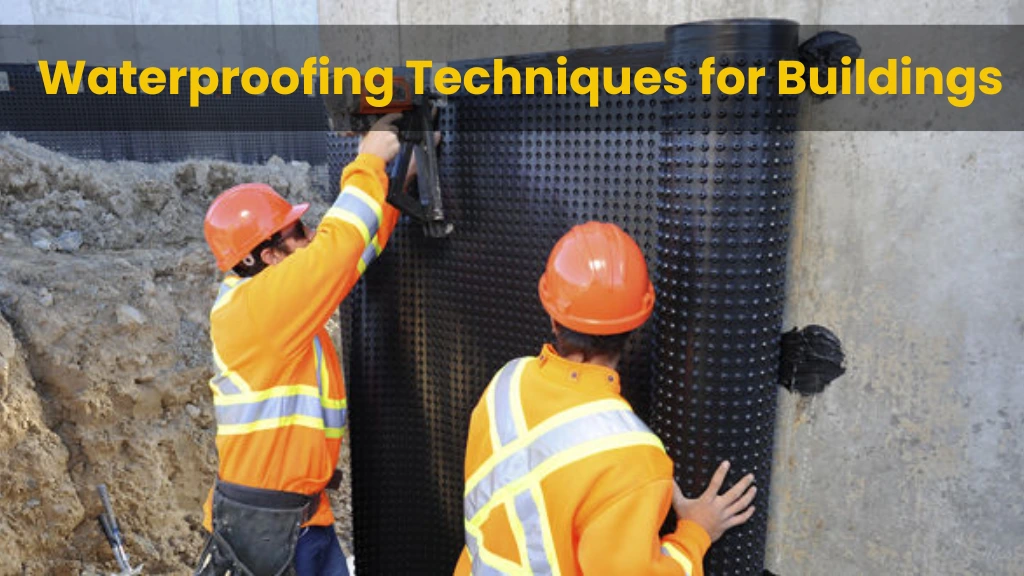The process of construction / building waterproofing is very important for construction projects because it delivers durability as well as structural stability and maintains water damage prevention. Buildings that lack adequate waterproofing measures become damaged to dangerous conditions such as leaking, moisture damage mold infestation, and structural damage which causes superior maintenance costs and safety hazards.
Various components of a building face damage caused by water throughout their foundations, roofs, basements, and walls. The current construction industry implements sophisticated water-resisting techniques which stop water penetration while maintaining structures for longer periods.
The article describes a comprehensive approach towards waterproofing systems together with material specifications and deployment methods for different building regions.
Why is Waterproofing Important?
Waterproofing is significant to the building structures which are very important for the success of any construction. It is important for pressing reasons that include the following:
- Protects structure from degradation – This is due to the fact that bathroom exposes concrete to water which leads to damaging of the structure, corrosion of reinforcement steel and production of cracks on the structures.
- Preserves Building Parts – Waterproofing ensures that water does not seep into the walls and floors to cause paint to peel or formation of mold on the interior part of the building.
- Enhances Indoor Air Standard – It reduces chances of mold and mildew formation hence improving the health status of the people in the room by preventing respiratory diseases and allergies.
- Improves the value of the property – a waterproofed and maintained building will help in increasing value of the property and also have reduced prices of repairs in future.
- Saves Energy – Since water proofing lessens the humidity level inside homes, the use of air conditioning and heating apparatus is not as frequent, hence saves energy.
Waterproofing Techniques for Different Building Areas
All portions of the building fall under different categories as far as waterproofing is concerned. Here is a list of efficient ways of addressing common waterproofing issues of foundation, roof, basement, and walls.
1. Foundation Waterproofing
Any structure, including a skeleton, requires a solid base whereon to be built; the same factor applies to a building as the foundation forms the base for the construction. Water leakage can lead to the formation of cracks in the foundation of the building, hence posing a threat to the structural integrity of the building.
Common Foundation Waterproofing Methods:
Cementitious Waterproofing
- One of the simplest and most cost-effective waterproofing methods.
- This is especially suitable for the extension of basements, water treatment facilities, and specially designed tunnels.
- They involve the application of cementitious materials that can easily stick on the concrete surfaces in a bid to inhibit water infiltration.
- Drawback: It is not as versatile compared to the first one and is not ideal for places that experience expansions and contractions.
Liquid Waterproofing Membrane
- It is applied in multiple layers so as to form a single one, but a continuously reinforcing waterproof layer.
- Applied in the construction of deep foundations, retaining sheds and walls, and construction of underground structures.
- If this material is used for a constituent member, it is highly flexible and resistant to cracks.
Bituminous Coating (Asphalt Waterproofing)
- A thick layer on the foundation walls is aimed at preventing water infiltration into the structure’s lower part.
- This is appropriate for below-ground constructions but not suitable for construction that is exposed to the sun.
Bentonite Waterproofing
- It is based on sodium bentonite clay that when water touches it swells and forms a barrier that no water can penetrate.
- Ideal for sealing against water mainly in basements and for the construction of foundation slabs of any building.
2. Rooftop Waterproofing (Terrace Waterproofing)
It plays the role of a shield and in the process is exposed to rain, and sleet, and ultraviolet rays and is thus susceptible to water and penetration. The need for water leakage protection is the main aspect of good roof waterproofing since it can significantly increase the protection time of the building structure.
Common Roof Waterproofing Methods:
Polyurethane Liquid Membrane
- It produces a smooth and easy-to-wear waterproof layer when in contact with the surface.
- Best for flat roofs, terraces, and balconies.
- Provides UV resistance and durability.
EPDM (Ethylene Propylene Diene Monomer) Roofing
- It is a synthetic rubber membrane that has the ability of withstanding various weather conditions and also has high resistance.
- Suitable for commercial and residential buildings.
- Offers excellent thermal insulation.
TPO (Thermoplastic Polyolefin) Roofing
- A thin, light, and pleated skin that improves performance in terms of energy.
- Highly resistant to UV rays, chemicals, and water infiltration.
Bituminous Membrane Waterproofing
- Often applied for flat and low-slope roofs since it is a material that bonds well and is resistant to water penetration.
- Available in self-adhesive or torch-applied sheets.
3. Basement Waterproofing
This is so because basements are often located below ground level and are therefore at a high risk of water leakage. It is a process of providing a barrier that will prevent water from penetrating through walls and floors causing structural damage.
Common Basement Waterproofing Methods:
Interior Waterproofing (Negative Side Waterproofing)
- Includes processes like applying waterproof paints or sealants on the internal side of the basement walls.
- Suitable for application in existing buildings that do not have a scope of external waterproofing.
- Utilizes water-repellent paints, coatings, and cementitious grout.
Exterior Waterproofing (Positive Side Waterproofing)
- It is used on the outer walls of the basement to avoid water infiltration into the sections of the house.
- Still, it is the most effective way of reclaiming the land but demands excavation.
French Drain System
- A method that helps to drain water away from the basement walls.
- Serving as a barrier all along the periphery of the basement to avoid water pooling.
Crystalline Waterproofing
- It is a chemical treatment that goes through the exterior and intrudes deep into the substance of a concrete floor, thereby filling up the cracks and porous spaces.
- Provides long-term moisture protection.
4. Wall Waterproofing
Floors, walls subjected to direct rain, humidity, or underground environment thus call for sound waterproofing to avoid dampness and decay on the surfaces.
Common Wall Waterproofing Methods:
Silicone-Based Sealers
- Beneficially, it can shield a structure without being seen, entering and exiting walls to defend it from water infiltration.
- Best for brick, concrete, and stone walls.
Acrylic Waterproofing Paints
- Used to also serve as a barrier to the penetration of water into the pores of an object.
- Comes in different colors to improve the look of the product.
Plaster Additives and Water-Resistant Mortars
- Reduce the water absorption rate of cementitious plasters.
- Commonly used for external walls.
Best Materials for Waterproofing
Selecting the right waterproofing materials is crucial for long-term effectiveness. Here’s a comparison of commonly used materials:
| Material | Best Used For | Key Benefits |
| Polyurethane | Roofs, terraces, and foundations | High flexibility, UV resistance |
| Bituminous Membrane | Roofs, basements, and foundations | Strong adhesion, long-lasting protection |
| Cementitious Coating | Basements, tunnels, and water tanks | Cost-effective, easy to apply |
| EPDM Membrane | Commercial roofs | Durable, excellent heat resistance |
| Bentonite Clay Sheets | Underground structures | Self-healing, excellent water resistance |
Conclusion
Waterproofing in architecture can therefore be described as a fundamental aspect of construction since it plays an important role in protecting structures, their durability, and their strength. Whether one is working on the construction of the structure or the foundation, roof structure, basement, or walls, it is good to know the various options in waterproofing as it will help the owner avoid rubbing a lot of cash at a later date in future in cases when the harms of waterproofing are realized.
Today, there are new age waterproofing like liquid applied membranes, bituminous coatings, and state of the art drainage systems ensure that buildings remain dry, safe and energy efficient for years. For people who are thinking of doing a new construction or even for those who are struggling with moisture problems in their property, it is advisable to seek professional help in providing good waterproofing service.
Read More: Earthquake-Resistant Building Design: Techniques & Standards
FAQs Waterproofing Techniques for Buildings
1. What is the best type of waterproofing that could be used on roofs?
There are several ways through which a roof can be waterproofed and the choice depends on the climate, type of roof, and the amount of money to be spent. Popular choices include:
Polyurethane liquid membrane for flat roofs
Bituminous membrane for long-lasting protection
Coating or sealants for the sloped roofs: acrylic or silicone
TPO or EPDM sheets for commercial buildings
2. How long does waterproofing last?
The above discussions outline that the lifespan of waterproofing is determined by the method used or the classification of the material used.
Cementitious waterproofing: 5-10 years
Bituminous coatings: 10-15 years
Polyurethane membranes: 15-25 years
Injection grouting of any structure can be done using various materials depending with the quality of the material to be injected.
3. Can I do the waterproofing of the basement on my own?
Minor damages such as cracks that may be found in the basement can be repaired by an individual by hiring a handyman contractor from the local market or even conducting the job independently using some paints that are specialized to prevent water seepage. But in cases of long-time recurring seepage, one requires the services of a professional in waterproofing whereby they can apply methods such as installing drainage systems, negative side waterproofing, or, injection grouting.
4. How much market value does one gain when a property is Waterproofed?
Yes, waterproofing increases property value by:
Preventing structural damage
Enhancing indoor air quality by reducing mold growth
Extending the lifespan of the building
Making the property more attractive to buyers
5. How much does it cost to waterproof a house?
This is to the size of the area to be painted, the techniques to be used, and the type of materials to be applied:
Cementitious waterproofing: ₹50-₹100 per sq. ft.
Bituminous membrane: ₹150-₹300 per sq. ft.
Polyurethane membrane: ₹250-₹500 per sq. ft.











For
300 Hundreds years Longevity of old Buildings.
Req.
1.Super Maintenance work Curing with painting.
2.Select Best waterproofing Technique.
3.Expart Civil professional for Valuable Advice.